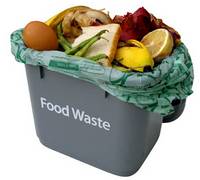A UK-based report has found that as much as half of the world’s food, amounting to two billion tonnes worth, ends up being thrown away.
The Institution of Mechanical Engineers said the waste was being caused by poor storage, strict sell-by dates, bulk offers and consumer fussiness.
The study also found that up to 30% of vegetables in the UK were not harvested because of their physical appearance.
Dr. Tim Fox from the Institution of Mechanical Engineers said the level of waste was “staggering”.
The report said that between 30% and 50% of the 4 billion tonnes of food produced around the world each year went to waste.
It suggested that half the food bought in Europe and the US was thrown away.

A UK-based report has found that as much as half of the world’s food, amounting to two billion tonnes worth, ends up being thrown away
Dr. Tim Fox, head of energy and environment at the Institution of Mechanical Engineers, said: “The amount of food wasted and lost around the world is staggering. This is food that could be used to feed the world’s growing population – as well as those in hunger today.
“It is also an unnecessary waste of the land, water and energy resources that were used in the production, processing and distribution of this food.
“The reasons for this situation range from poor engineering and agricultural practices, inadequate transport and storage infrastructure through to supermarkets demanding cosmetically perfect foodstuffs and encouraging consumers to overbuy through buy-one-get-one-free offers.”
He added: “If you’re in the developing world, then the losses are in the early part of the food supply chain, so between the field and the marketplace.
“In the mature, developed economies the waste is really down to poor marketing practices and consumer behavior.”
The report – Global Food; Waste Not, Want Not – also found that huge amounts of water, totaling 550 billion cubic metres, were being used to grow crops that were never eaten.
The institution said the demand for water for food production could reach 10 to 13 trillion cubic metres a year by 2050.
The United Nations predicts there will be an extra three billion mouths to feed by 2075 as the global population swells to 9.5 billion.
Dr. Tim Fox added: “As water, land and energy resources come under increasing pressure from competing human demands, engineers have a crucial role to play in preventing food loss and waste by developing more efficient ways of growing, transporting and storing foods.
“But in order for this to happen governments, development agencies and organization like the UN must work together to help change people’s mindsets on waste and discourage wasteful practices by farmers, food producers, supermarkets and consumers.”
The UN food and agricultural body announces that global food prices sharply rebounded in July due to wild swings in weather conditions.
The rise has fanned fresh fears of a repeat of the 2007-2008 food crisis which hurt the world’s poorest.
Untimely rains in Brazil, drought in the US and production difficulties in Russia drove the rally, said the Food and Agriculture Organization (FAO).
Food prices jumped 6% in July from June after falling three months in a row.
The FAO food price index measures the monthly price changes for a basket of food commodities including cereals, oilseeds, dairy, meat and sugar. The index reading in July was still well below the all-time high reached in February 2011.
The Rome-based organization took the surprise step of publishing the index this month – which it usually does not – due to the exceptional market conditions affected by unusual weather patterns.

The UN food and agricultural body announces that global food prices sharply rebounded in July due to wild swings in weather conditions
Cereal prices surged 17%, while sugar leapt 12% to new highs in July from the previous month after rains hampered sugarcane harvesting in Brazil, the world’s largest producer.
Delayed monsoons in India and poor rains in Australia also contributed to higher prices.
“The severe deterioration of maize crop prospects in the US following extensive drought damage pushed up maize prices by almost 33% in July,” said the FAO.
The price of rice and dairy was unchanged, although meat fell 1.7% due to a slump in pork prices.
The surge in prices have renewed fears of a food crisis that plagued countries in 2007-2008, sparking violent street protests in countries like Haiti and Egypt.
“There is a potential for a situation to develop like we have back in 2007-2008,” said FAO senior economist and grain analyst Abdolreza Abbassian.
“There is an expectation that this time around we will not pursue bad policies and intervene in the market by restrictions, and if that doesn’t happen we will not see such a serious situation as 2007-2008. But if those policies get repeated, anything is possible,” he added.
Higher food prices hurt the world’s poorest countries because it means they will need to pay higher import bills as they do not produce enough food at home.
Oxfam said that since the beginning of the year, rising food prices and drought had caused a food crisis in the Sahel sub-region of west and central Africa, affecting more than 18 million people over an area of land as wide as the US.
“This is not some gentle wake-up call – it’s the same global alarm that’s been screaming at us since 2008,” said Hannah Stoddart, Oxfam’s head of economic justice policy, regarding the FAO data.
“These latest figures prove yet again that there is something fundamentally flawed in the way we produce and distribute food around the world. For too long our leaders have stood by complacently, while up to a billion people go hungry worldwide,” she said.
“The time to act is now.”


